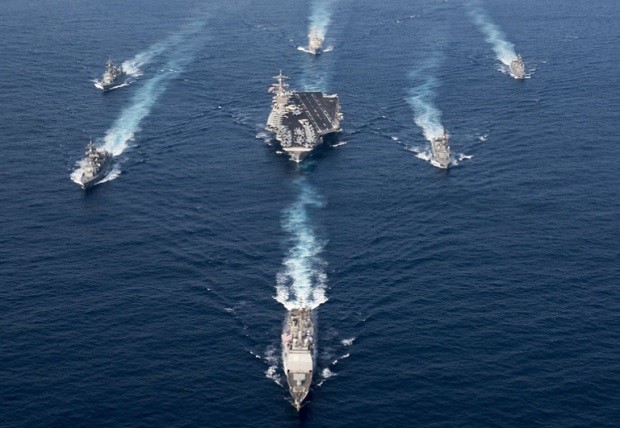
Japan Maritime Self-Defense Force destroyers JS Hamagiri (DD-155), JS Samidare (DD-106), JS Umigiri (DD-158), JS Yudachi (DD-103) and Nimitz-class aircraft carrier USS Carl Vinson (CVN 70), Arleigh Burke-class guided-missile destroyer USS Wayne E. Meyer (DDG 108) and Ticonderoga-class guided-missile cruiser USS Lake Champlain (CG 57) sail in formation in the Philippine Sea in this March 28, 2017, photo. US NAVY PHOTO / MCS 3RD CLASS MATT BROWN
WASHINGTON, United States — The Trump administration on Wednesday tried to clear the waters after it gave confusing messages concerning the whereabouts of a US supercarrier that supposedly was steaming toward North Korea last week.
Amid soaring tensions ahead of North Korea’s apparent ramping up for a sixth nuclear test, the US Navy on April 8 said it was directing a naval strike group headed by the USS Carl Vinson aircraft carrier to “sail north” from the waters off Singapore, as a “prudent measure” to deter Pyongyang.
“We are sending an armada. Very powerful,” were the words of President Donald Trump, and other officials made it sound like the ships were plowing toward the region.
READ: North Korea vows response to ‘reckless’ US carrier strike force
“A carrier group steaming into an area like that, the forward presence of that is clearly… a huge deterrent. So, I think it serves multiple capabilities,” White House spokesman Sean Spicer said April 11.
Pentagon chief Jim Mattis said the Vinson was “on her way up” to the region.
But the Navy on Tuesday admitted the ships were in fact sent in the opposite direction — away from Singapore and toward Australia to conduct drills with the Australian navy.
Defense officials said the Vinson wouldn’t be anywhere near North Korea before next week at the earliest — it is thousands of nautical miles from the Java Sea where the ship was located over the weekend to the Sea of Japan.
Critics pounced on the discrepancy as a dangerous miscommunication, saying it fed into North Korea’s narrative that America is all bluster and doesn’t follow through on threats.
‘It is happening’
It also comes as the White House faces ongoing credibility issues on a broad range of topics including the size of Trump’s inaugural crowd, his unsubstantiated claim that he was “wiretapped” by the Obama administration and his unsupported assertion millions of votes in November’s election were illegal.
“The president said that we have an armada going towards the peninsula. That’s a fact. It happened. It is happening, rather,” Spicer said Wednesday as he tried to clarify the issue.
Speaking to reporters in Saudi Arabia, Mattis said the Pentagon had tried to be open about the Vinson’s whereabouts.
“We generally don’t give out ship schedules in advance but I did not want to play a game either and say we were not changing the schedule when in fact we have,” he said.
“She will be on her way. I will determine when she gets there and where she actually operates, but the Vinson is going to be part of our ensuring that we stand by our allies in the northwest Pacific.”
Rear Admiral Jim Kilby, who heads the Vinson strike group, wrote on Facebook late Tuesday that the ships’ deployment “has been extended 30 days to provide a persistent presence in the waters off the Korean Peninsula.”
James Faeh, a former Pentagon country director for Korea during the Obama administration, said the Vinson deployment was not a make-or-break development, given that the United States already has a massive array of military hardware and tens of thousands of troops in the region to deter Pyongyang.
He told AFP the rhetoric coming from the Trump administration on North Korea was “overheated and risky,” but the strike group’s deployment was “not at all outside of the mainstream.”
North Korea staged a massive military parade on Saturday and observers widely expected the country to conduct a sixth nuclear test to coincide with celebrations marking the birthdate of regime founder Kim Il-Sung.
But that test hasn’t happened yet, though North Korean leader Kim Jong-un attempted to launch a missile Sunday that the Pentagon said blew up almost immediately after launch. CBB